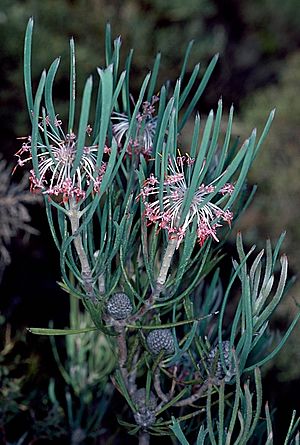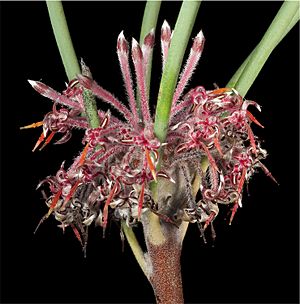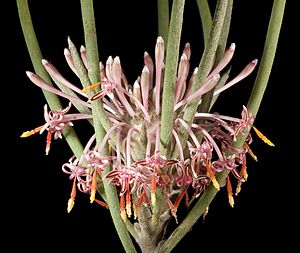Isopogon scabriusculus facts for kids
Quick facts for kids Isopogon scabriusculus |
|
|---|---|
 |
|
| Subspecies scabriusculus | |
| Scientific classification | |
| Genus: |
Isopogon
|
| Species: |
scabriusculus
|
| Synonyms | |
|
|
Isopogon scabriusculus is a beautiful flowering plant. It belongs to the Proteaceae family, which includes many unique Australian plants. This special shrub only grows in the southwestern part of Western Australia. You can recognize it by its interesting leaves and its lovely pink or red flowers. These flowers grow in round or oval clusters.
Contents
About This Plant
Isopogon scabriusculus is a shrub that usually grows up to about 2 meters (about 6.5 feet) tall and wide. It has branches that are reddish-brown or grey.
Leaves and Flowers
- Its leaves can be cylindrical (like a tube), grooved, or flat and narrow.
- They can grow up to 180 millimeters (about 7 inches) long.
- Sometimes, the leaves are forked, meaning they split into two parts.
- The flowers mostly grow at the ends of the branches.
- They form round or oval heads, up to 30 millimeters (about 1.2 inches) across.
- These flower heads have special leaf-like parts called bracts at their base.
- The flowers are usually red or pink and can sometimes be a bit hairy.
Fruit
- After the flowers, the plant produces a small, hairy nut.
- Each nut is about 3.5 millimeters long.
- Many of these nuts join together to form a round head, up to 16 millimeters (about 0.6 inches) across.
Naming and Types
The plant Isopogon scabriusculus was first officially described in 1856. This was done by a scientist named Carl Meissner. He wrote about it in a big book called Prodromus Systematis Naturalis Regni Vegetabilis.
Different Subspecies
In 1995, another scientist, Donald Bruce Foreman, found that Isopogon scabriusculus actually has three different types, called subspecies. These subspecies are slightly different from each other.
- Subspecies pubifloris
- This type is a shrub that grows up to 1.2 meters (about 4 feet) tall.
- It has simple, cylindrical leaves up to 130 millimeters (about 5 inches) long.
- Its pink flowers are hairy and grow from September to November.
- The fruit cones are about 12 millimeters (about 0.5 inches) wide.
- Subspecies scabriusculus
- This type can grow up to 2 meters (about 6.5 feet) tall.
- It has flat leaves that can be up to 180 millimeters (about 7 inches) long.
- Sometimes, its leaves have three lobes (parts).
- Its pink flowers are smooth (not hairy) and grow from July to October.
- The fruit cones are about 16 millimeters (about 0.6 inches) wide.
- Subspecies stenophyllus
- This shrub grows up to 1.5 meters (about 5 feet) tall.
- It has simple, grooved leaves that are oval in shape when you look at them from the side.
- These leaves can be up to 160 millimeters (about 6.3 inches) long.
- Its red or pink flowers are smooth (not hairy) and grow from July to October.
- The fruit cones are about 12 millimeters (about 0.5 inches) wide.
What the Names Mean
The name scabriusculus means "a little rough." The name pubiflorus means "softly hairy-flowered," which describes its fuzzy flowers. And stenophyllus means "narrow-leaved," referring to its slender leaves.
Where Does It Grow?
Isopogon scabriusculus is found all over the southwest of Western Australia. It likes to grow on sandy plains and ridges.
Locations of Subspecies
- Subspecies pubifloris grows in scrub, shrubland, and woodland areas. You can find it between Hyden, Southern Cross, Coolgardie, Lake King, and the Frank Hann National Park.
- Subspecies scabriusculus grows in mallee (a type of eucalyptus woodland), scrub, and heath. It is found between Mullewa and Newdegate.
- Subspecies stenophyllus grows in heath and shrubland. It is mainly found between Wubin, Southern Cross, and Newdegate.
Is It Endangered?
Good news! All three subspecies of Isopogon scabriusculus are considered "not threatened." This means they are not currently at risk of disappearing, according to the Western Australian Government's Department of Parks and Wildlife.



